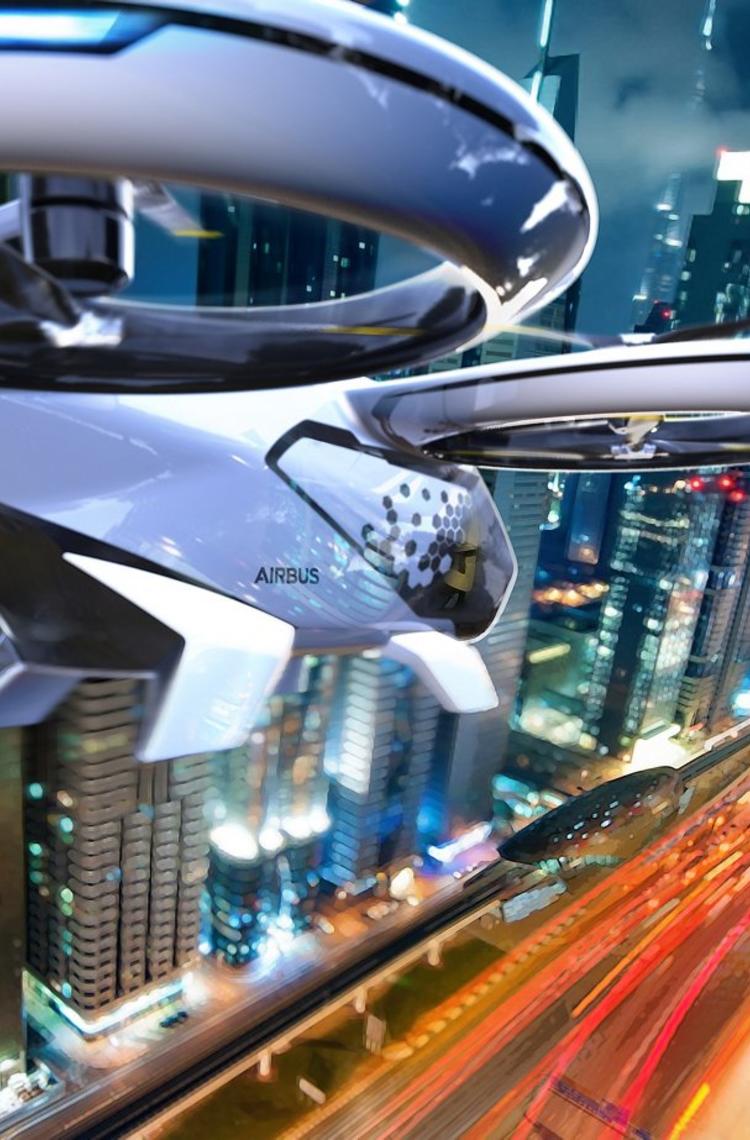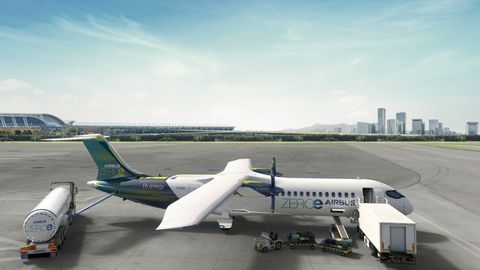The future of transport lies in the skies. By developing a range of cutting-edge autonomous technologies, Airbus is working towards a world of self-piloting urban air mobility vehicles, cargo drones and more autonomous commercial aircraft. The vision: a safer, more efficient and eco-friendly global transport network.
Handing control of a vehicle over to a machine can be a strange feeling. “On the first few journeys, it’s hard to relax,” says Dirk Dickmanns. The expert for image-based automation knows what he is talking about. Before joining Airbus 10 years ago, he helped programme autonomous cars at BMW. He learned that few people believe a computer can compete with their own abilities in this respect. “But, over time,” Dickmanns explains, “this feeling changes. And I believe that in future, machines will be safer, more efficient drivers and pilots than humans are.”
Dickmanns is one of many people across Airbus working to turn the goal of autonomous flight into reality. It’s a complex, wide-ranging field: not only does it involve designing and building aircraft that can ‘think’ and fly themselves, but also establishing new ground infrastructure, air traffic management systems and working with authorities to regulate entirely new modes of transport, from cargo drones to flying taxis.
Increasing urbanisation means the skies above our cities hold the key to fast, efficient travel in the future.
Tailored human-machine interaction
One of the reasons behind Airbus’ drive towards greater autonomy is a rapid growth in air travel. Commercial aviation traffic is set to double in the next 15 years; and increasing urbanisation means the skies above our cities hold the key to fast, efficient travel in the future.
“By harnessing powerful computer technology and increasing levels of autonomy, we can optimise flight trajectories,” says Pascal Traverse, Head of Autonomy at Airbus. “We expect this to bring multiple social and environmental benefits, such as saving fuel and reducing noise, as well as allowing for easier vehicle sharing and easing the burden on our natural resources.”
Traverse says any discussion of autonomy must first outline what the term means. “We consider a system to be autonomous when it is able to take decisions without human acknowledgement or initiation,” he explains. “But autonomy is not an all-or-nothing proposition, rather a tailored human-machine interaction that evolves over time. Look at the cockpit crew for commercial aviation: we went from four to three and now two.” Now, Airbus is concentrating on reducing the workload of the crew further. Autonomous technologies will allow the crew to focus more on managing the mission instead of managing the machine. ”Eventually, this could mean reducing the size of the crew for long-haul flights from three or four to two, or even single-pilot operations.
Meet the autonomous flight experts
Harini Kulatunga, Head of Future Solutions for Unmanned Aerial Systems
“Without automating airspace control, we cannot realise the future we imagine. We are currently in the process of setting up projects in several countries to better understand how we can integrate drones into our airspace in a safe, reliable manner.”
Pascal Traverse, Head of Autonomy at Airbus
“By harnessing powerful computer technology and increasing levels of autonomy, we can optimise flight trajectories. We expect this to bring multiple social and environmental benefits, such as saving fuel and reducing noise, as well as allowing for easier vehicle sharing and easing the burden on our natural resources.”
Dirk Dickmanns, expert for image-based automation
Handing control of a vehicle over to a machine can be a strange feeling. “On the first few journeys, it’s hard to relax, but over time, this feeling changes. And I believe that in future, machines will be safer, more efficient drivers and pilots than humans are.”
Nicolas Damiani, Senior Expert in Systems Simulation at Helicopters
“Our EAGLE project is currently combining these aspects to build a complete vision system. This will enable high-performance power for image-processing algorithms – enhancing the image recognition capabilities of an autonomous aircraft.”
Arne Stoschek, Head of Autonomous Systems at A³ by Airbus
“Autonomous cars have gone from proof of concept to a commercial reality in just over a decade. Here in Silicon Valley, I see them on the road every day. With Vahana, we have already demonstrated that autonomous flight is a realistic concept. Imagine what we will be able to do with autonomous flight in the next 10 years and the amazing opportunities this presents to Airbus.”
Autonomous flight – the applications
Autonomous systems are already in place in a number of Airbus products used for intelligence, surveillance and reconnaissance. Satellites and remotely piloted aircraft are able to fly alone under supervision from a ground-based operator. In case communication is lost, they can still execute certain pre-programmed actions. The next step is to have these vehicles make more intelligent decisions in the air, such as verify the quality of the images they are taking and retake if necessary, rather than send them to the ground for human assessment; or communicate with other satellites that may be better positioned to take pictures.
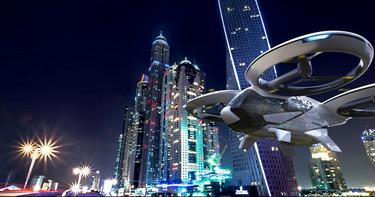
Cargo drones and flying taxis
A more visible use of autonomous systems will be their role in transporting goods and people. We can expect to see cargo drones buzzing ahead and self-piloted vehicles whisking passengers from the airport to the city centre.
In February 2018, Airbus’ Skyways parcel delivery drone successfully completed its first flight demonstration in Singapore, while prototyping for the Quadcruiser to deliver heavier loads such as medical supplies is also underway. And in January this year, Vahana, a project aimed at advancing electric, self-piloted VTOL (Vertical Take-Off and Landing) flight, made its maiden test flight and is currently progressing through the next stage of testing. Development on the multi-passenger CityAirbus, which also uses self-piloting, VTOL and electric propulsion technology, is progressing well, with a first flight scheduled for the end of 2018.
As Harini Kulatunga, Head of Future Solutions for Unmanned Aerial Systems, explains, a major increase in the number of aircraft in the sky will require a new system to manage the traffic. “Without automating airspace control, we cannot realise the future we imagine. We are currently in the process of setting up projects in several countries to better understand how we can integrate drones into our airspace in a safe, reliable manner. There are a number of challenges to overcome: they have to be able to talk to each other, react to changes in weather conditions and recognise no-fly zones such as airports. We hope to partner with start-ups and key technology companies to realise this vision within the next two years.”
Kulatunga says some of the work she and her team are doing will eventually be transferable to commercial, helicopter and urban air mobility flights. But before that, it is a twin task of developing technology and liaising with aviation authorities to find the right regulatory framework. “We need to work as one team to position Airbus as the leader in this key technology enabler that will drive new business in the future,” she says.
Autonomous technologies will allow the crew to focus more on managing the mission instead of managing the machine.
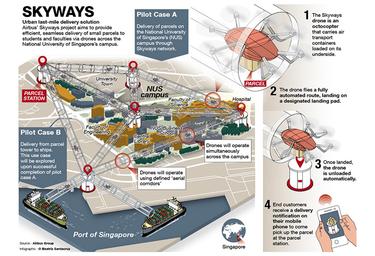
Helping aircraft to see
For any vehicle to fly autonomously, it has to be able to ‘see’. Colleagues Experts across the company, including Dirk Dickmanns at Defence and Space, and Nicolas Damiani, Senior Expert in Systems Simulation at Helicopters, are working on image-capturing technology. “Our task is to provide the basis of autonomy. Computer vision is provided via various sensors such as HD cameras as well as radar or lidar data,” Damiani explains. “Our EAGLE project is currently combining these aspects to build a complete vision system. This will enable high-performance power for image-processing algorithms – enhancing the image recognition capabilities of an autonomous aircraft.”
One area of focus is to automate take-off and low-speed manoeuvres for VTOL and landing via image recognition: an aircraft automatically identifies a helipad or runway, assesses the adequate final approach and controls the flight accordingly, until landing. “The main challenge is data integrity in reduced visibility – is the system really recognising a runway? Or is it, perhaps, a road, canal or rowing lake?” says Dickmanns. “To overcome this, we have to generate better algorithms for the computer systems that are more sensitive to distinguishing different features.”
To accelerate this technology, this April Airbus launched a project to modify an A320 test aircraft. Named ATTOL – Autonomous Taxi, Take-Off and Landing – the demonstrator aims to unite all Airbus divisions and innovation centres to work together.
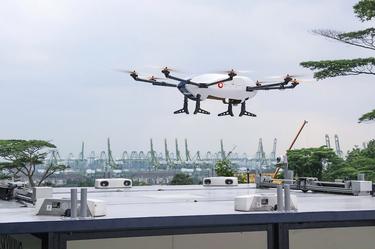
Sense and avoid
A similar principle lies at the heart of what is perhaps the most important element of autonomous flight – sense and avoid technology. Arne Stoschek, Head of Autonomous Systems at A3 by Airbus, has been working on Vahana for two years. “The key technology at Vahana is artificial intelligence, in particular deep learning – a very powerful mathematical method that allows the vehicle to understand a complex environment and then make decisions.”
It’s all based on a vast amount of data captured using drones that emulate how and where Vahana would fly, as well as the obstacles it would encounter. Stoschek says he and his five-man team have gathered 400,000 data points, from images of aircraft to birds in the sky. “We use this data to train a computer model. Like a human, the computer model learns from the experiences presented through the data we collect and update it with. We’ll continue to collect data to push future, verified versions to the on-board system. The fixed capabilities of the on-board guidance system thereby know how to react to each event. What makes deep learning so interesting is that it is robust in dealing with the many different situations and environments that aircraft can operate in.”
Like Dickmanns, Stoschek has a background in autonomous cars and he sees parallels with the rapid progress in autonomous flight. “Autonomous cars have gone from proof of concept to a commercial reality in just over a decade. Here in Silicon Valley, I see them on the road every day. With Vahana, we have already demonstrated that autonomous flight is a realistic concept. Imagine what we will be able to do with autonomous flight in the next 10 years and the amazing opportunities this presents to Airbus.”
